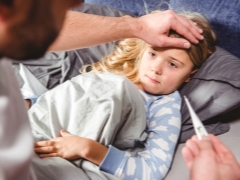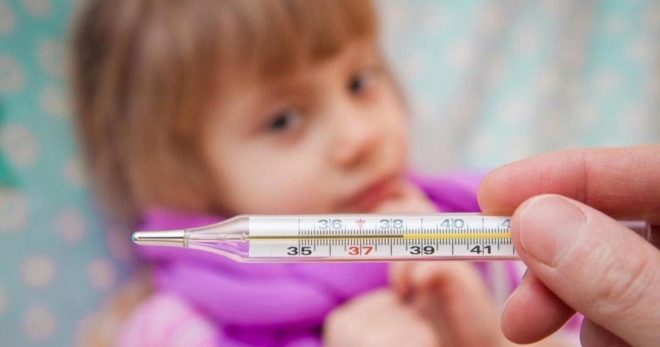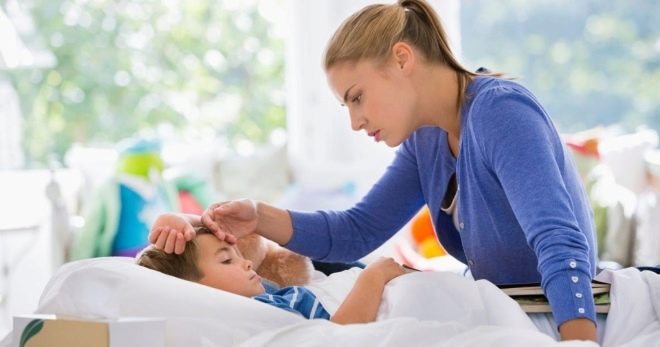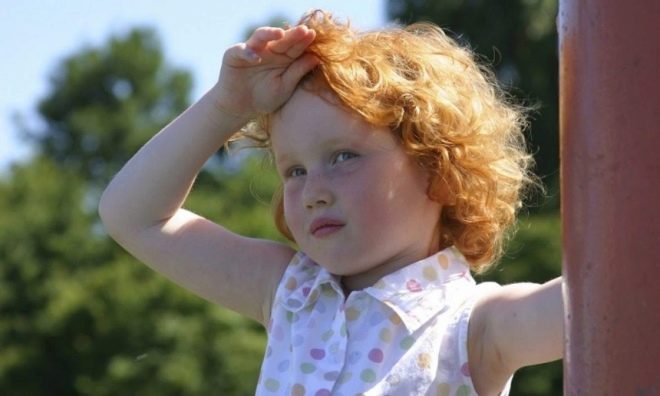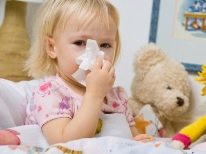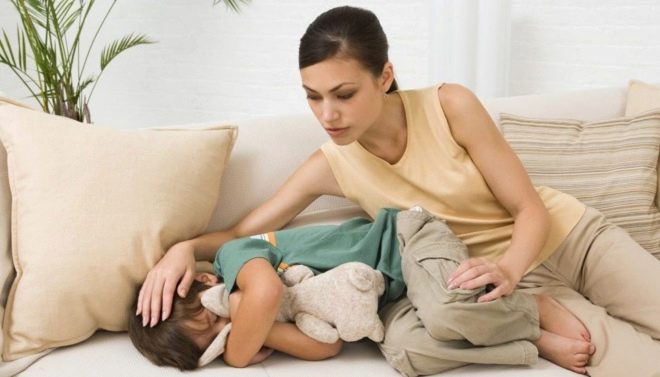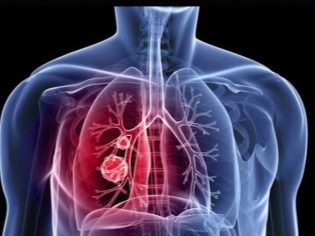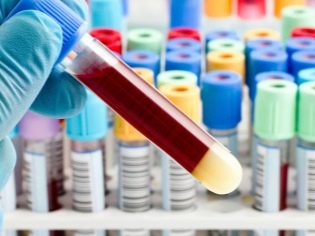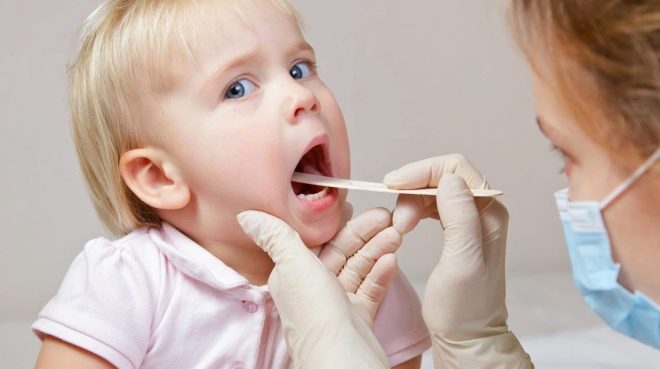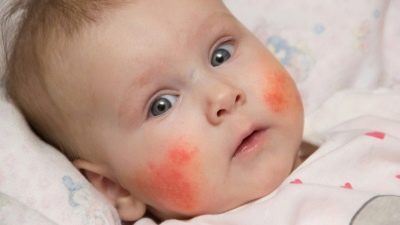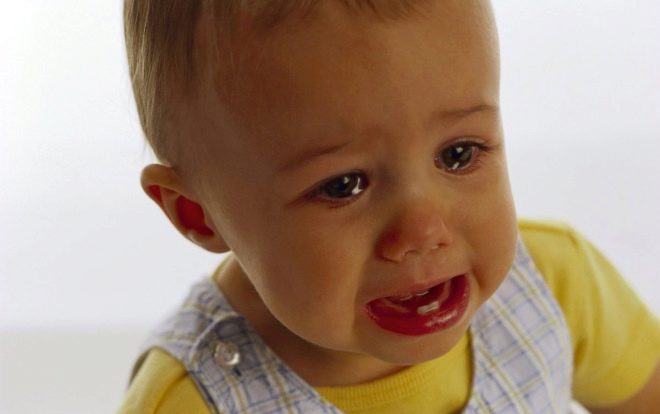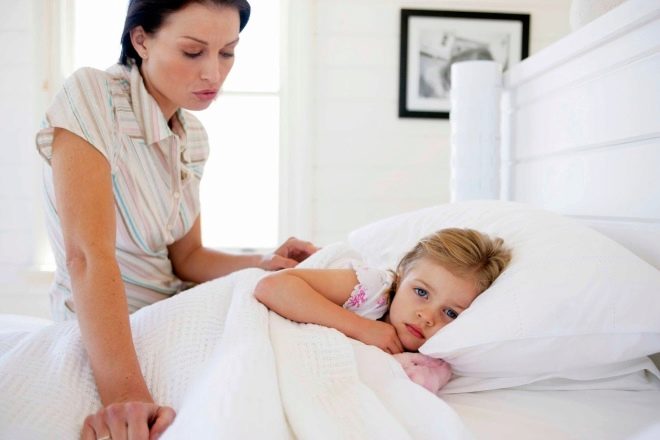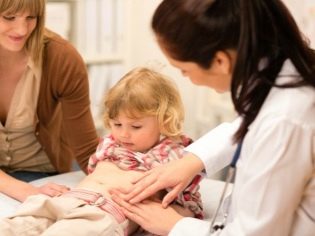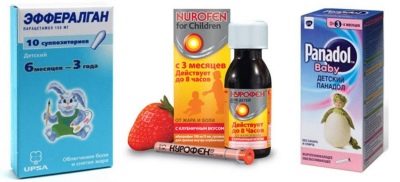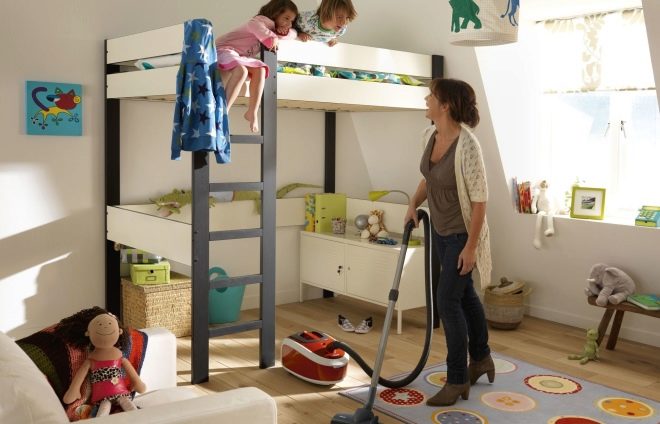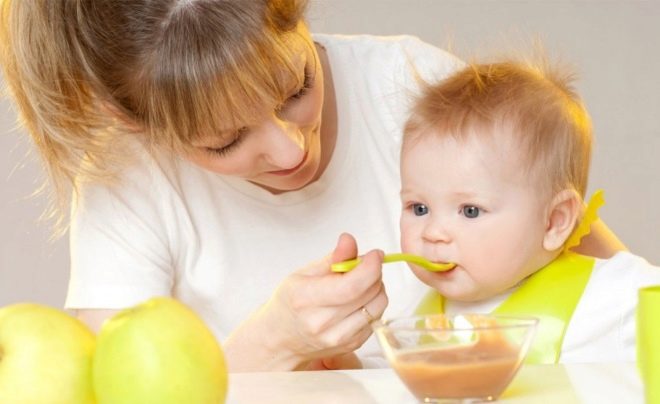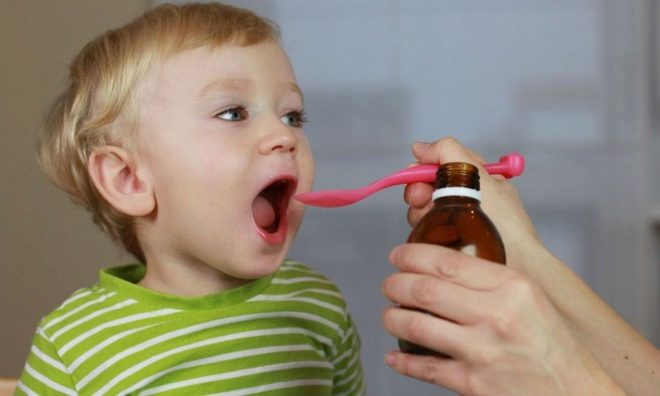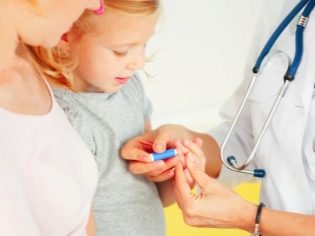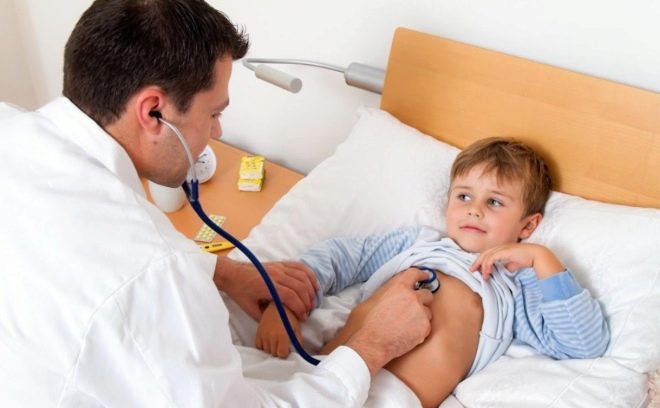Why can a child have a fever with no signs of a cold and what to do?
Rarely how can parents raise a child and never face an incomprehensible sharp increase in body temperature without other symptoms. No cold, no cough, no sore throat, and the thermometer stubbornly tends to 39.0 degrees. The worst thing for moms and dads in this situation is complete uncertainty. When it is not clear that the baby has a pain, adults feel great anxiety and confusion. In this article we will explain why the temperature rises without signs of a cold, and what parents should do in this situation.
What's happening?
If a child suddenly has a high fever, it means that his immunity desperately “fights” with a certain pathogen that claims the right to settle in the children's organism. Raising the temperature to high values (above 38-39 degrees) without signs of a cold or other complaints from a baby always says only that an acute infection has begun.
It can cause both bacteria and viruses. But in most cases in childhood there are viral infections. It may seem to parents that the disease develops without symptoms, in fact, signs may appear some time later. Heat - often the very first sign of beginning ARVI.
Bacterial infections, as a rule, have a clear symptomatic picture, and without symptoms, the temperature does not rise.
The child’s body is trying to “kill” the pathogen with high fever, because for most viruses only the natural environment of the human body with normal temperature is ideal. In addition, in the heat, immunity more actively produces specific antibodies to the invading pathogen.
Of course, there are special cases when the high temperature is associated with overheating in the sun or cutting teeth in infants, as well as the reaction of the child’s body to the next vaccination. But the diagnosis of such conditions usually causes no questions to the parents. It is much more difficult to understand what is actually happening if there is a fever and no other symptoms. Let's look at several likely causes of what is happening with the child.
Possible reasons
Most viruses are respiratory. Influenza, parainfluenza, respiratory-Sentential virus and rhinovirus are most likely to manifest catarrhal symptoms - cough and runny nose, difficulty in nasal breathing, hoarseness, redness of the inflamed oropharynx, headache. If the first “start” is a high temperature, parents need to calm down and take an observant post at the child’s bed. With most acute respiratory viral infections symptoms will appear in the first day.
Respiratory viruses (of which there are several hundred) infect cells of the ciliated epithelium of the upper respiratory tract, the temperature rises in response to the "invasion". But no symptoms at all. Careful observation will show in a few hours a runny nose, current transparent snot, dry cough, an older child may begin to complain of headache, pain in joints and muscles.
So, ARVI is the main and most common cause of spontaneous rise in temperature. But there are others.
Enterovirus infection
This infection (or rather, a large group of diseases caused by enteroviruses) is in second place in terms of the incidence in children. We are talking about different serotypes of the Coxsackie virus, about ECHO. A child can become infected with one of these viruses anywhere, anytime, and the symptomatic picture may be different - from a sudden rise in temperature to the development of diarrhea, vomiting, cough and runny nose.
Even if the temperature is the only symptom, it makes sense to wait a bit. With a high degree of probability, either catarrhal or intestinal phenomena will appear (for which the enterovirus infection is often called the intestinal flu in the people).
Urinary tract infections
The absence of cold symptoms on the background of high temperature may well be a sign of an inflammatory process in the urinary tract. Children have such a disease - a very frequent occurrence. About 20% of all cases of high fever for no apparent reason account for just pyelonephritis and cystitis. The most difficult thing in this case is with babies who cannot explain where and what they have pain.
Parents need to carefully monitor the nature of urination - when urination is frequent, when the baby cries during urination, when the urine color and smell change, you should immediately consult a doctor.
Atypical pneumonia
Since the middle of the last century, the proportion of pneumonia with an unclear clinical picture has increased by 35%. This phenomenon is called "mute" or "atypical" pneumonia. There is fever without obvious catarrhal signs, and even cough is not always present.
Atypical pneumonia can develop as an independent disease caused by bacteria or fungi, or as a complication of a previous viral infection. A characteristic feature may be the time to increase the heat.
If a child has recently suffered a viral illness (commonly referred to as the common cold), and after a week or 10 days he had a sharp "jumped" high fever, but there are no other signs of the disease, you should definitely contact a pediatrician and do tests, it is possible complication.
Tuberculosis
The temperature itself is not necessary for tuberculosis, but practice shows that it occurs quite often. It can rise to 38.0-38.5 and stay for a long time, and can be subfebrile (slightly above 37.0 degrees). In tuberculosis, the child feels a significant decline in strength, he has increased sweating, he is very weak. Immunity begins to decline rapidly, which can cause secondary complications.
Herpesviruses
High fever can rise from certain types of herpes virus diseases. If the viruses of the first and third types (common herpes on the lips and chickenpox) have no relation to the topic we are discussing, since they are always accompanied by characteristic rashes in characteristic places, then Epstein-Barr virus, for example, may well “start” from a high temperature.
A little later develops swelling of the tonsils, plaque on the tongue and throat, as well as an increase in lymph nodes (not inflammation, but an increase). Lymph nodes are painless, whereas during inflammation it is almost impossible to touch them - the child will cry from pain.
Even more frequent causes of sudden temperature without other associated symptoms and signs is the fifth herpesvirus - cytomegalovirus infection. Also, in children aged 1,2,3 years, herpesvirus of the sixth type or the so-called “roseola infantile” or “sixth disease” is very common. With it, the temperature rises suddenly and immediately to 39.0 degrees and above. No other symptoms. But exactly three days later the fever subsides and a pink rash appears all over the body.
Herpesviruses of the sixth and seventh types in children are quite rare. They are also expressed by an increase in temperature, as well as a significant decrease in immunity.
Parvovirus infection
High temperatures can rise from the penetration of parvoviruses into the children's body.The disease proceeds, as with most viral infections - it begins with a high temperature, then a rash can join, often the cheeks of the children redden, the erythema persistent, lasts for several days. Then the baby may begin to complain of joint pain. Almost always, parvovirus infection is accompanied by anemia.
In addition, the cause of a strange sharp fever may be any autoimmune disease, bacteremia, any internal inflammatory process in which the child simply can not report that he has pain, but because parents sincerely believe that there are no other symptoms.
There is also psychosomatic fever. She is usually affected by shy children who are prone to frequent and severe stress. Due to the regular increased synthesis of adrenaline, they develop adrenaline hyperthermia.
As soon as the baby is frightened or upset, he can react with violent heat. For such babies, the best treatment is to calm down.
Procedure
As you can see, there can be quite a few reasons for a rise in temperature without the attendant symptoms of a cold or other diseases. Naturally, the responsibilities of parents do not include diagnosis of the causes. But much depends on the correct reaction and accuracy of the actions of mom and dad in this situation. So, how to act when a child has a high fever:
Put the baby to bed. Bed rest will help to save the strength and energy that the baby now needs for a speedy immune response to the invasion of the disease-causing organism. If the temperature is above 39.0 degrees, the question usually does not arise how to lay down and keep the child in bed. At this temperature, the child will lie himself - the body knows exactly what it needs right now.
- Carefully inspect the child. Strip the baby, in daylight natural light inspect the skin. Mark any changes - rash, pimples, spots. Examine the scalp for a rash. Ask to stick out the tongue, assess whether there is any raid on it. Using a clean spatula or the base of a spoon, lightly press the tip of the tongue and see if the tonsils and larynx have not reddened. Rate nasal breathing - is the baby breathing freely? Look at the stomach - is it bloated, is it soft? Examine the color and amount of urine. Anything discovered or not found, tell your doctor, who must also be called immediately.
- Call the doctor. This seemingly simple point needs special explanations. And this is why: infants suffer more high fever, babies have a higher risk of developing febrile seizures due to high body temperature. If the child is from 0 to 1 year, immediately call "Ambulance."
If the child is older, then you can call the district pediatrician from the clinic, provided that the yard is not deaf night and the temperature itself is no higher than 38.5. If the night and 39.0 - also call the "Ambulance."
Remember what happened the day before. Be sure to consider the factors that could lead to a rise in temperature. If a child returned a few days ago with his parents from a trip to a tropical country, it is possible that he has one of the "exotic" diseases. If the baby has eaten a new food, gastrointestinal reactions and food allergies are not excluded. If the day before you had guests and a child played with them for a long time and emotionally, then the cause of the heat can be psychosomatic, caused by stress and overexcitement of the nervous system. Be sure to tell all that the doctor was able to remember, this information will help him quickly diagnose.
Children older than 3 years can be given a single antipyretic agent, wait for the morning and then call a doctor from the clinic. When deciding which doctor to call and from where, rely on the child's well-being.
- Provide proper care before your doctor arrives. Actively water the child with water without gas, unsweetened tea or compote. The younger the baby, the more important it is to prevent dehydration. Strip the baby.Let it be covered with a light sheet, and not a quilt, while it is recommended to leave only the panties on it. If we are talking about an infant, it is better to replace a disposable diaper with a gauze one, so that the body heat transfer is more uniform. Do not leave the baby alone in the room, as he may experience convulsions that will require your participation in first aid.
Do not give your child any drugs, even antipyretic. The doctor must assess the condition of the baby without the action of drugs.
You will learn more about the procedure for dealing with a child’s illness by watching the following video.
General treatment rules
At high temperatures without other symptoms, a waiting tactic is recommended. As can be seen from the description of the possible causes of this phenomenon, with the majority of diseases that are common in children, which begin with high fever, the symptoms will still appear, just a little later.
The waiting tactics means that the child does not need to immediately be given antibiotics or any other drugs, because the reason for the increase in temperature is not yet known. Knowing that in nine out of ten babies in such a situation, one of the viral infections, build child care on the general rules of treatment of viral ailments.
In the room where the baby is lying, it must be ventilated and washed - wet cleaning and open air vents are mandatory actions that must be done immediately after the baby has been looked at by the doctor. If the doctor does not take the child to the hospital, suspecting something serious, the treatment will fall on the shoulders of the parents.
In the room you need to create conditions that will help the baby’s immunity to cope with the disease faster. In addition to clean air, you should pay attention to the temperature - the room should not be hotter than 21-22 degrees. If the family has such a device as a humidifier, it should be turned on and ensure that the humidity in the room is at the level of 50-70%.
If there is no such device, hang wet diapers and towels over the batteries and make sure they do not dry out - wet them in a timely manner.
Such environmental parameters will help to avoid complications of viral diseases associated with drying of the nasopharynx, mucous membranes of the upper respiratory tract.
A child must drink a lot and eat little. Do not try to feed the child at any cost by any means. If he himself asks to eat, you can give light food, which will be quickly absorbed, without requiring a large amount of energy consumption for the digestion process. Such food may include fruit salad, porridge, vegetable puree, steam cutlet. Cakes and fatty meat is better not to give.
The temperature should be reduced only when it begins to threaten the state. Heat is a protective mechanism required by the child’s immunity. Therefore, it is necessary to give antipyretic drugs only after the thermometer “oversteps” the mark of 38.5 in infants and children under 2 years old, and 39.0 in children 2 years and older. To reduce the temperature it is better to use drugs based on paracetamol. For children of different ages, you can choose either syrup, or tablets, or rectal suppositories.
Do not rub the child with alcohol or vodka, immerse him in a cold bath. Such actions can cause vasospasm. And even more so it is not necessary to rub the child off with a badger or other fat. This will disrupt the heat and cause overheating of the entire body.
Do not try to treat what is not. You can often hear that the parents begin to inhale the child and place the banks when the fever appears. And they do it not because he has a cough. Moms are trying to prevent this cough and think that they are "ahead of the curve." The only thing that is really worth doing if you really want to treat something with something is to bury the homemade salt solution in the nasal passages as often as possible (to prevent the latter from drying out), as well as gargling with the same salt solution.
If new symptoms appear, you should definitely inform your doctor. As prescribed by the doctor, it is imperative to do general blood and urine tests, as well as an immunological blood test, which will show the presence of antibodies to certain viruses.
Dr. Komarovsky about the problem
Renowned pediatrician Yevgeny Komarovsky argues that parents should not try to find the exact name of the virus that hit their child. The name of the virus and its strain in most cases do not play any role at all. Since the approach to the treatment of all viral diseases is about the same - to drink, to moisten the air and not to overfeed.
It is not worth demanding from the pediatrician that he accurately and precisely now called the cause of the high temperature. The doctor, like you, does not know her. That is why he prescribes tests, which, perhaps, will be able to answer the question about the reasons. In no case should one refuse to pass tests.
To the parents' question about how long they should wait, if other symptoms never appear, Komarovsky answers that the work of the immunity of each individual child is individual. But there is a rule that states that the lack of improvement in the condition on the 4th day after the onset of the disease is an unambiguous reason to call the doctor if this has not been done before, or to call it again if the parents have already invited the medical specialist to the baby on the first day.
In most cases, according to Yevgeny Olegovich, improvement still occurs in the first four days. Parents can affect this, if they properly care for the baby.
